Whether eaten alone, in sauce or even cooked, wasabi is a must in Japan. So here is an article dedicated to this super plant!
- Wasabi, an essential condiment in Japanese cuisine
- Wasabi, an aquatic plant
- The true flavors of wasabi
- The products derived from wasabi
Wasabi, an essential condiment in Japanese cuisine
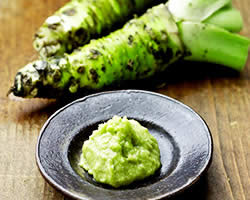 You all know from near or far the wasabi “わさび” “山葵”. You have already tasted it in a Japanese restaurant while eating sushi. Or you have seen some in one of those famous green tubes in the exotic shelves of your supermarket. Indeed, ou of Japan we can find this product quite easily, whether it is in powder or fluorescent green paste.
You all know from near or far the wasabi “わさび” “山葵”. You have already tasted it in a Japanese restaurant while eating sushi. Or you have seen some in one of those famous green tubes in the exotic shelves of your supermarket. Indeed, ou of Japan we can find this product quite easily, whether it is in powder or fluorescent green paste.
Often called Japanese mustard, wrongly so since the real Japanese mustard is karashi “からし”. Many also think that this wasabi is nothing else than a horseradish root. In fact, wasabi is a plant in its own right belonging to the Brassicaceae family.
Here are the preconceived ideas we have about wasabi in pictures:
Horseradish root
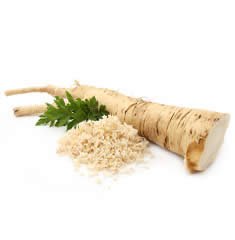
Karashi mustard

The wasabi
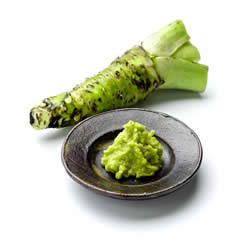
Wasabi, an aquatic plant
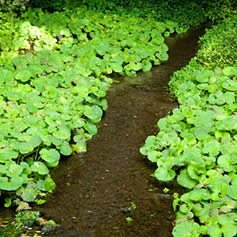
Wasabi loves water and grows spontaneously in Japan. The soil must be permanently filtered by fresh and pure water.
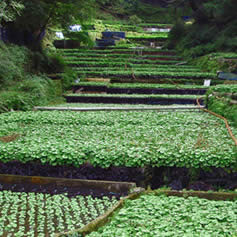
These small gardens located on the slopes of Mount Fuji offer ideal conditions for making high quality wasabi.

Here is an example of mass culture of wasabi. This one will be cheaper but of more average quality.
This plant pushes naturally in the very wet grounds even swampy. However it needs a flow of water which should not stagnate at the risk of making the plant rot. The growers thus compete of ingenuity by making small plots from which water flows in cascade.
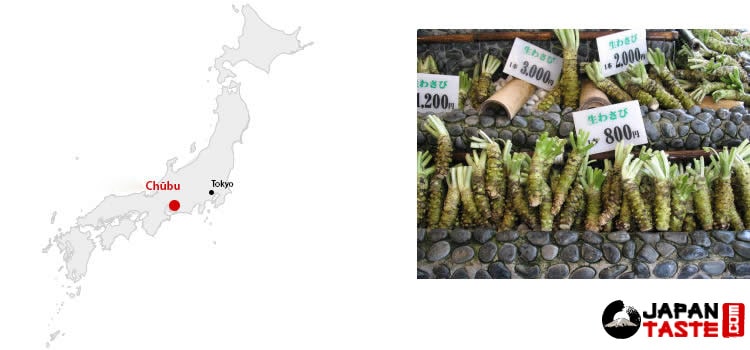
The region of Chūbu is the cradle of this plant. The saint of the wasabi saints is therefore in Shizuoka Prefecture at the foot of Mount Fuji itself, or rather on its slopes. Where there is no lack of water and low temperatures are ideal for good cultivation. These should not be too hot in the summer nor too cool in the winter. In the best farms, the plant is truly pampered and harvested with care, especially when we know that the plant takes about 4 years to be harvested!
Nothing is lost, the root will be used for wasabi paste, the stems and leaves are also consumed in various dishes. The best roots reach very high prices!
If you want to eat sushi with wasabi but the wasabi is too strong, you can mix it with soy sauce. You will obtain a delicately flavoured sauce that will delight your taste buds without overpowering the taste of the fish.
The true flavors of wasabi
Outside of Japan, the taste of the wasabi in tube that you can get can either seem very strong or agreeable, but what always comes back is that this paste stings the nose. See tears off the nose and makes you cry depending on the marks.
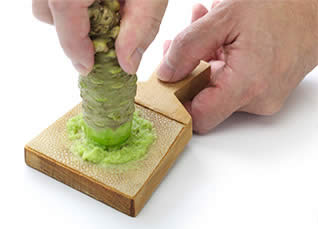 But it is not the case with fresh wasabi. The subtle aromas of the freshly grated plant are unparalleled! The subtle flavors and its freshness are counterbalanced by a soft power. It does not immediately rise to the nose as one would expect and the flavors are really delicate.
But it is not the case with fresh wasabi. The subtle aromas of the freshly grated plant are unparalleled! The subtle flavors and its freshness are counterbalanced by a soft power. It does not immediately rise to the nose as one would expect and the flavors are really delicate.
It is really the perfect condiment to accompany fish. And it’s even more pleasant to make it by rubbing it on a wooden board covered with shark skin than to eat this fluo paste!
The products derived from wasabi
Wasabi has become quite “trendy” so there are a lot of derivative products. Here are some of them.

We can find quite classic things like peanuts, cashews, or wasabi coated sesame seeds. Chips, crackers and even cheese complete the savoury products. Of course, there are also furikake “ふりかけ” to flavour your rice. But that’s not all!
We also find this one in the sweets section! Ramune lemonade and even tasty wasabi ice cream are available all over Japan, kakigori, cupcakes and Kit Kat! Indeed, the brand we all know is also very well known in Japan. It offers a considerable range of tastes more improbable the ones than the others including wasabi which is not bad by the way.
One buys the box especially in the idea to collect it or to say to oneself that one has already tasted this or that perfume. Here is our complete article on Kit Kat chocolates in Japan.
In short you will have understood it, we find this plant a little bit everywhere. But in its purest form it is really delicious.





